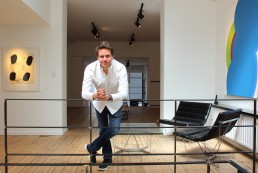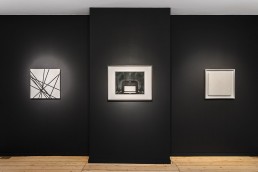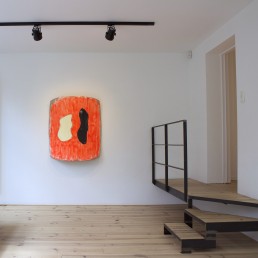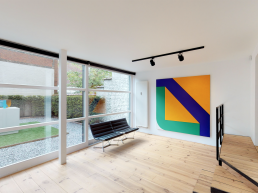Interviews
Quentin Grosjean of QG Gallery, Brussels

"and then Frank Stella was there as well and luckily I caught him smoking a cigar outside and I joined him and it was really a great conversation....that’s when I really knew that this was for me and that I would keep going."
In a quiet side street in Brussels, in the elegant neighbourhood of Ixelles, is a modest yet elegant shopfront housing QG Gallery. It is the eponymous premises of Quentin Grosjean, a young Belgian dealer with a big passion and deep knowledge of twentieth century art, and with the kind of discerning eye needed to sift critically through it’s neglected treasures. Quentin Grosjean’s current exhibition is entitled ‘Color and Space’, an exhibition of paintings by German painter Georg Karl Pfahler, and the first of his work in Belgium since 1964. Pfahler was an important modernist pioneer, and among the first to develop the prevalent modes abstraction espoused by abstract expressionism into a more rigorous hard edged minimal abstraction. The exhibition is emblematic of Quentin Grosjean’s gallery model and practice, and also indicative of the direction in which he is taking his programming. His gallery’s renown has been based upon his adeptness at formulating stringently curated thematic exhibitions, often with an idea of rediscovery and with a determination to approach this work with museological rigor. The current exhibition extols this approach but also hints at a future path, that which includes representing artist’s and their estates in addition to developing markets within neglected aspects of the secondary art dealing field.
We visited Brussels to visit the gallery so we could talk first hand with Quentin Grosjean about his gallery, his practice and his plans for the future.

Quentin, great to see you, thanks for making time for us today. When did you open the gallery and what was your main idea for the space?
We opened in September 2017. For the gallery itself, the concept was built around finding the right space, to create a feel that is closer to a collector’s home rather than the typical white cube contemporary gallery today, and that really also helped me dictate the concept – so that the collector can really picture the art work in his home, rather than have a surprise when they get an artwork home and it really doesn’t work in their interior.
Did you spend a long time looking for a premises that had this feel and fit this idea?
I did not actually. I had 2 streets in mind particularly that were at the heart of the main gallery areas, whether it was close to the area with Xavier Hufkens, or this area here with Charles Riva, Albert Baronian etcetera. We are five in our street. Anyway, I wanted to make sure I was in one of the main areas known for contemporary art here in Brussels. Luckily I found it very quickly, and I knew it was the right fit. It all happened very fast.



What was your first exhibition?
The exhibition was called ‘Minimal Structure’. It was a play on words because of the minimal structure of the gallery being in a small space, but also because it consisted of artists where Minimalist ideas were considered to be at the core of their work. We showed Kenneth Noland, Francois Morellet, Carlos Cruz Diez, but also some more underrated artists like Walter LeBlanc and Jo Delahuat. But yes, it was mainly about the line. Most artists in the show used line as a fundamental structure of their work.
"it's very easy to collect with your ears rather than your eyes"
So you’re interested in groupings of artists that share ideas, and in creating connections or a lineage within a movement.
That’s correct, and in that way that I can also highlight a few of them that I find underrated, and then make the connection with very established artists. It sort of shines a new light on their work, sometimes successfully so, when they get viewed within a context like this. Collectors then have the opportunity to rediscover somebody. And also in a way, some of the artists are very renowned in Europe and not so much in the US, or the other way around, and so it allows collectors to view and consider within an international context that is not often highlighted. For instance George Rickey is under represented in Europe, but is considered an important pioneer in the USA.
Do you regularly come across things that capture your interest and make you think ‘ok, I want to find a place for this in what I do’ or do you already have a set idea for what you want to show and sell?
The initial idea was really to focus on curated group shows but now we’re going to move towards working with estates as well. I think there’s a lot of work to do with these under the radar artists, from the 60s, 70s and 80s there are so many artists that under exposed.
For instance we are now showing paintings by Georg Karl Pfahler who is a German artist from the 60s. He was influenced by the traditions of European art, but quickly simplified his paintings to adopt an innovative abstract geometric painting style, with block-like forms on crisp backgrounds appearing on his first mature canvasses as early as 1962. In our show we have a group of paintings from the 60s to the 80s, some of which were part of the Signal exhibition in Basel in 1967, a prestigious group show in which his work was shown alongside Al Held, Elsworth Kelly, Kenneth Noland, and Jules Olitski. The following year, having gained his status as one of the leading European artists of his generation and supported by the curator Barnett Newman, he presented his first show in the United States, at the Fischbach Gallery in New York. He also represented Germany at the Venice Biennale in 1970, alongside Günther Uecker, Heinz Mack and Thomas Lenk, and also at the Sao Paolo Biennial in 1981.
He was spearheading a movement in which Ueker and Mack are sort of the second acts and he was very big at the time.

Why do you think someone of that pedigree, or artists who had a profile like that, fall into obscurity. Just historical accident, or what do you think?
Well a number of reasons really. You had galleries in Germany that represented the work very well, and they closed down for various reasons, whether it was the gallery owner retiring, or just bad business. It takes an artist time to find a new gallery with whom they can agree, about all the things that are needed. And getting that together just slows things down, and once these artists lose a few years with blanks on the cv then it’s kind of a vicious circle for these artists – it can be hard to come back.
I see. They kind of fall between the cracks in the art system?
That’s right and so in that sense we’re also going to use the concept of rediscovery in our program, and also the Rediscovery section at Art Brussels. That was the purpose of the booth we just had with Pfahler, and next year we will show somebody else who fits this idea and so it’s a good platform to show an artist – only for four days but it puts their work in front of several thousand people. It’s very efficient.
You started out with the idea of not representing artists, but now moving towards the idea of working with estates. I suppose this relates to the way you can historically position things, but also to have a bigger role in developing a market for things that are under exposed?
That’s correct, I think our role as a gallery is to have an impact on these artists’ careers, and to try and work with museums, to try and boost their visibility, and that’s something I didn’t want to miss by just working within the secondary market. So that’s a way in for me to have that fun part of the job to help an artist’s estate, but at the same time keeping the concept of working with underrated artist from those periods.
Historically in the art world there has been a distinction between an art dealer and a gallerist. Maybe the gallerist term has become a more recent phenomena to describe the activity of promoting artists and really advocating for them, building their careers. Putting together curated exhibitions and now with the estate work you have just described it gives you an opportunity to combine these 2 kinds of slightly alternate roles?
I really think that’s the way forward and I will include these artists in my group shows , and even in some circumstances like for instance in our ‘Abstract USA’ show we worked directly with Paul Kremmer to add a painting to the show, because we wanted to establish the links of Calder and Stella to the contemporary scene, and really showcase the evolution. So we can make exceptions sometimes.

Is there a particular period or group of artists that were the catalyst for you to firstly develop a passion and then get involved as a career choice?
I think what really was the biggest catalyst was when I was very young working
with a gallery called Maruani Noirhomme, they’re now working as Maruani Mercier, and I had the opportunity to go to Vienna and to meet Peter Halley who was having a show there. And then Frank Stella was there as well and luckily I caught Stella smoking a cigar outside and I joined him and it was really a great conversation. It was inspiring meeting the person behind the work and it really had a big impact on me. That’s when I really knew that this was for me and that I would keep going.
But then in terms of movement and periods, I personally love American Minimalism, particularly Robert Mangold, Laurence Weiner, Robert Barry, which maybe is more about conceptual art, but they I think blend together in some sense.
Did you have a background studying art?
I did not, but I grew up with a collecting mother who is very passionate and she dragged me to museums since I was four or five years old. Actually, at first she had to drag me but pretty soon I needed less persuading! I was lucky to grow up with works by Halley and Kusama on the walls, and so it gives you a big exposure – you become sensitive to art very fast.
It’s in your heritage and it has become a passion. You could say that doing it this way is like getting paid to be involved with your hobby!
I think yes, that’s sort of the concept too. It’s partly my collection and its completely reliant on my eye. And so curating the shows myself and building them from scratch is really showing my sense of the art world today without any outsider influence.
What would be the advice maybe you might give to a collector who was looking into finding a point of entry into building a collection?
I think not to get too caught up in the frenzy of emerging contemporary art world because its very easy to collect with your ears rather than your eyes, and I think to study deep and to find those underrated artists who had an impact on art history.
Traditionally the auction houses would also try and make markets for artists who had been somehow overlooked a bit. Whenever their promotion of a certain artist had become a bit too saturated, or the prices had got too high, they would try and follow the filter down effect to the next artist from that generation or movement. If you look at the scholarship and the institutional collections, it is like the market has to catch up with the art history.
In a similar way you can see the works of Kenneth Noland as an example, the prices of target paintings versus shape paintings from his minimalist period, there is a huge difference in the prices, but the quality of the work I really don’t see that big of a difference. These artist periods will come back. Once they run out of target paintings they will have to look to the shape canvases.
What are some of the future projects you have in mind?
We are putting together an exhibition of works on paper by American artists of the Eighties in our gallery in Knokke, in which we will have works by Robert Mangold, Fred Sandback, Sol LeWitt, Donald Judd, and then this summer we will host a solo show of Piero Dorazio, a very underrated Italian artist.
In September for Brussels Gallery Weekend we have a show planned with a working title of ‘Abstrakt’, with the German spelling, the idea being an abstract show presenting a wide range of works by German artists from the modernist period through to contemporary, from Albers all the way to Katharine Grosse, also with works by Gunther Förg, Imi Knoebel, Hans Hartung, Heinz Mack, and Gunther Uecker. We are really excited about that.
It has been great to chat with you, Quentin. Congratulations on your wonderful gallery space and your inspired approach to your gallery program. We wish you every success and look forward to checking in on your progress from time to time.

Relevant sources to learn more:
Gallery
QG Gallery
Opening year
2017
Opening Times
Tue-Sat
11am-6pm
+32 (0) 2 513 53 22
Address
62, Rue de La Concorde
1050 Bruxelles